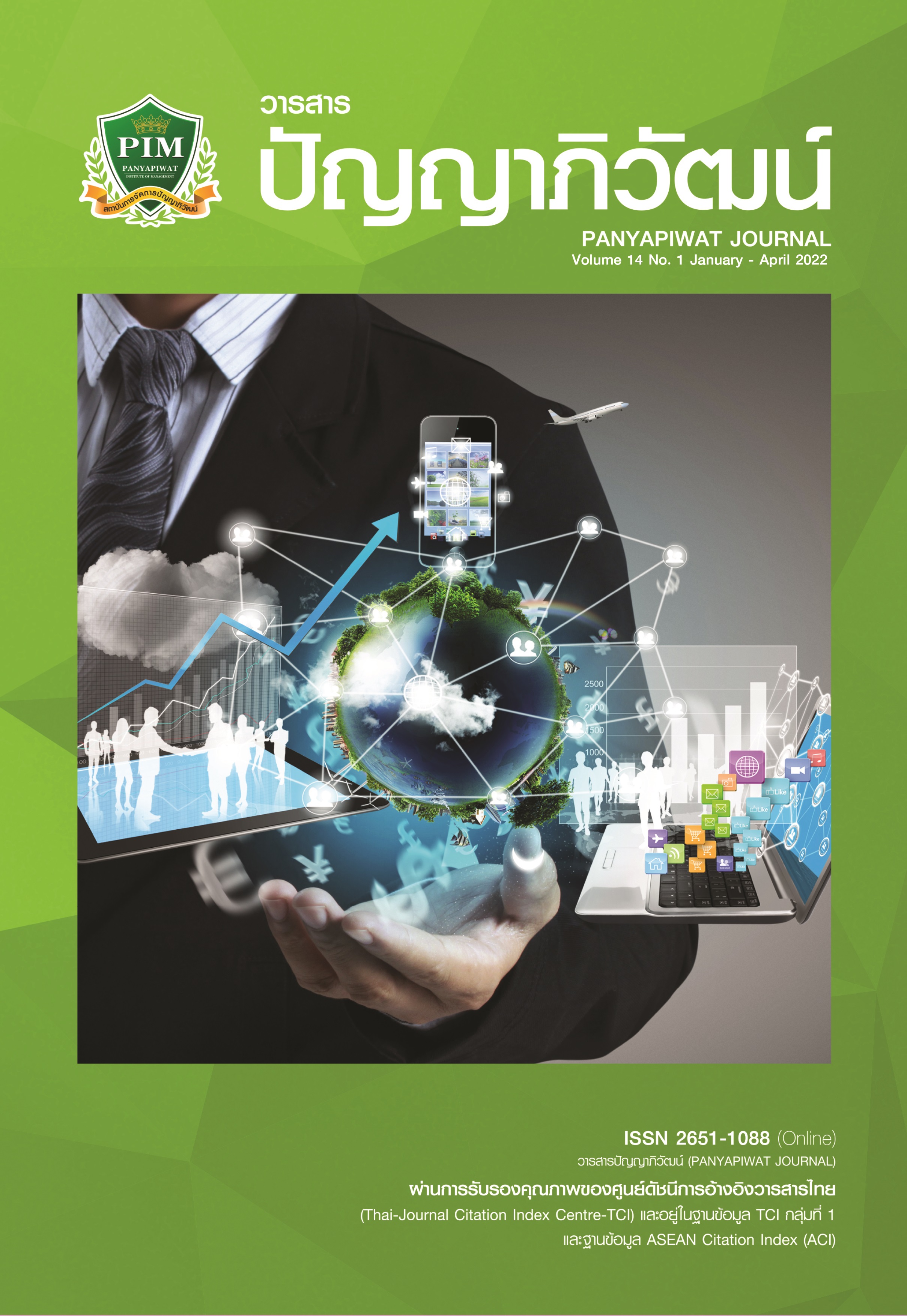บุพปัจจัยสาเหตุและผลการสร้างการรับรู้ตราสินค้าใหม่: หลักฐานเชิงประจักษ์ของสินค้าตราใหม่
Main Article Content
บทคัดย่อ
การวิจัยนี้มีวัตถุประสงค์เพื่อศึกษา 1) บุพปัจจัยสาเหตุของการสร้างการรับรู้ตราสินค้าใหม่ 2) การส่งผลของการรับรู้ตราสินค้าใหม่ โดยรวบรวมข้อมูลการสัมภาษณ์ผู้บริหาร จำนวน 14 ท่าน ผู้ประกอบการ จำนวน 275 ราย และเก็บข้อมูลโดยใช้แบบสอบถามจากผู้บริโภคสินค้าตราสินค้าใหม่ จำนวน 1,098 รายทั่วประเทศ วิเคราะห์ข้อมูลโดยการวิเคราะห์โมเดลสมการเชิงโครงสร้าง ผลการวิจัยตามสมมติฐานของการศึกษาพบว่า ปัจจัยเชิงสาเหตุ ได้แก่ กลยุทธ์การเปิดตัวผลิตภัณฑ์ใหม่ในบริบทตราสินค้าใหม่ผ่านแรงกระตุ้นการรับรู้ ตราสินค้าใหม่ มีอิทธิพลเชิงบวกต่อการรับรู้ตราสินค้าใหม่ ส่วนผลของการรับรู้ตราสินค้าใหม่มีอิทธิพลเชิงบวก ต่อความภักดีต่อตราสินค้าของผู้บริโภค โดยมีความพึงพอใจของผู้บริโภคเป็นตัวแปรส่งผ่าน และความพึงพอใจของผู้บริโภคมีอิทธิพลเชิงบวกต่อความภักดีต่อตราสินค้าของผู้บริโภค โดยผลการศึกษาที่ได้นั้นสามารถใช้เป็นแนวทางในการดำเนินกิจกรรมสร้างการรับรู้ตราสินค้าใหม่ให้ประสบความสำเร็จต่อไป
Article Details

อนุญาตภายใต้เงื่อนไข Creative Commons Attribution-NonCommercial-NoDerivatives 4.0 International License.
“ข้าพเจ้าและผู้เขียนร่วม (ถ้ามี) ขอรับรองว่า บทความที่เสนอมานี้ยังไม่เคยได้รับการตีพิมพ์และไม่ได้อยู่ระหว่างกระบวนการพิจารณาลงตีพิมพ์ในวารสารหรือแหล่งเผยแพร่อื่นใด ข้าพเจ้าและผู้เขียนร่วมยอมรับหลักเกณฑ์การพิจารณาต้นฉบับ ทั้งยินยอมให้กองบรรณาธิการมีสิทธิ์พิจารณาและตรวจแก้ต้นฉบับได้ตามที่เห็นสมควร พร้อมนี้ขอมอบลิขสิทธิ์บทความที่ได้รับการตีพิมพ์ให้แก่สถาบันการจัดการปัญญาภิวัฒน์หากมีการฟ้องร้องเรื่องการละเมิดลิขสิทธิ์เกี่ยวกับภาพ กราฟ ข้อความส่วนใดส่วนหนึ่งและ/หรือข้อคิดเห็นที่ปรากฏในบทความข้าพเจ้าและผู้เขียนร่วมยินยอมรับผิดชอบแต่เพียงฝ่ายเดียว”
เอกสารอ้างอิง
Aaker, D. A. (2004). Leveraging the corporate brand. California Management Review, 46(3), 6-18.
Barajas-Portas, K. (2015). The impact of consumer interactions in social networking sites on brand perception. Journal of Internet and e-Business Studies, 2015, 1-8. http://doi.org/10.5171/2015.197131
Batey, M. (2015). Brand Meaning: Meaning, myth and mystique in today’s brands (2nd ed.). Routledge.
Belén del Río, A., Vazquez, R., & Iglesias, V. (2001). The effects of brand associations on consumer response. Journal of Consumer Marketing, 18(5), 410-425.
Brexendorf, T. O., Bayus, B., & Keller, K. L. (2015). Understanding the interplay between brand and innovation management: Findings and future research directions. Journal of the Academy of Marketing Science, 43(5), 548-557.
Echchakoui, S. (2016). Relationship between sales force reputation and customer behavior: Role of experiential value added by sales force. Journal of Retailing and Consumer Services, 28, 54-66.
Foroudi, P., Jin, Z., Gupta, S., Foroudi, M. M., & Kitchen, P. J. (2018). Perceptional components of brand equity: Configuring the symmetrical and asymmetrical paths to brand loyalty and brand purchase intention. Journal of Business Research, 89, 462-474.
Fraenkel, S., Haftor, D. M., & Pashkevich, N. (2016). Salesforce management factors for successful new product launch. Journal of Business Research, 69(11), 5053-5058.
Fritz, K., Schoenmueller, V., & Bruhn, M. (2017). Authenticity in branding-exploring antecedents and consequences of brand authenticity. European Journal of Marketing, 51(2), 324-348.
Giovanis, A. N., & Athanasopoulou, P. (2018). Consumer-brand relationships and brand loyalty in technology-mediated services. Journal of Retailing and Consumer Services, 40, 287-294.
Hair, J. F., Black, W. C., Babin, B. J., Anderson, R. E., & Tatham, R. L. (2006). Multivariate data analysis (6th ed.). Pearson Prentice Hall.
Hapsari, R., Clemes, M. D., & Dean, D. (2017). The impact of service quality, customer engagement and selected marketing constructs on airline passenger loyalty. International Journal of Quality and Service Sciences, 9(1), 21-40.
Jenkins, M. T. (2017). The role of supply chain resource orchestration and supply chain knowledge in improving product launch performance in emerging markets [Doctoral dissertation]. University of Tennessee, Knoxville.
Kim, J. W., Lee, F., & Suh, Y. G. (2015). Satisfaction and loyalty from shopping mall experience and brand personality. Services Marketing Quarterly, 36(1), 62-76.
Kotler, P. (2017). Marketing for competitiveness. Bentang Pustaka.
Kotler, P., & Keller, K. (2005). Marketing management. Pearson International.
Lehtimäki, T. K. (2012). Managing the new product launch process: Cross-functional information exchange perspective. International Journal of Advances in Management and Economics, 1(4), 31-41.
Matikainen, M., Terho, H., Matikainen, E., Parvinen, P., & Juppo, A. (2015). Effective implementation of relationship orientation in new product launches. Industrial Marketing Management, 45, 35-46.
Numbang, K., & Pasunon, P. (2016). Factors of brand image perception to brand value of motorcycles in bangkok metropolitan. Journal of the Association of Researchers, 21(2), 135-145. [in Thai]
Nunnally, J. (1978). Psychometric theory (2nd ed.). Mcgraw-hill.
Oliver, R. L. (2014). Satisfaction: A behavioral perspective on the consumer (2nd ed.). Routledge.
Palací, F., Salcedo, A., & Topa, G. (2019). Cognitive and affective antecedents of consumers’ satisfaction: A systematic review of two research approaches. Sustainability, 11(2), 431.
Pallant, J., & Manual, S. S. (2010). A step by step guide to data analysis using SPSS. McGraw-Hill Education.
Pasunon, P. (2014). Determination of sample size according to Krejcie and Morgan guidelines (1970) in quantitative research. The Journal of Faculty of Applied Arts, 21(2), 112-120. [in Thai]
Rungtrakulchai, R. (2018). The relationship between price deals, perceived quality, and brand equity for a high involvement product. AU Journal of Management, 11(2), 36-45.
Rovinelli, R. J., & Hambleton, R. K. (1976). On the use of content specialists in the assessment of criterion-referenced test item validity. The University of Massachusetts: Laboratory of Psychometric and Evaluative.
Scott, D. M. (2011). Real-time marketing and PR: How to instantly engage your market, connect with customers, and create products that grow your business now. John Wiley & Sons.
Scherpen, F., Draghici, A., & Niemann, J. (2018). Customer experience management to leverage customer loyalty in the automotive industry. Procedia-Social and Behavioral Sciences, 238, 374-380.
Schivinski, B., & Dabrowski, D. (2016). The effect of social media communication on consumer perceptions of brands. Journal of Marketing Communications, 22(2), 189-214.
Tartaglione, A. M., Cavacece, Y., Russo, G., & Granata, G. (2019). A systematic mapping study on customer loyalty and brand management. Administrative Sciences, 9(1), 1-21.
Wanichbancha, K. (2014). Structural Equation Analysis (SEM) with AMOS (3rd ed.). Samlada Limited Partnership. [in Thai]
Wiedmann, K. P., Labenz, F., Haase, J., & Hennigs, N. (2018). The power of experiential marketing: Exploring the causal relationships among multisensory marketing, brand experience, customer perceived value and brand strength. Journal of Brand Management, 25(2), 101-118.
Zoellner, F., & Schaefers, T. (2015). Do price promotions help or hurt premium-product brands?: The impact of different price-promotion types on sales and brand perception. Journal of Advertising Research, 55(3), 270-283.


